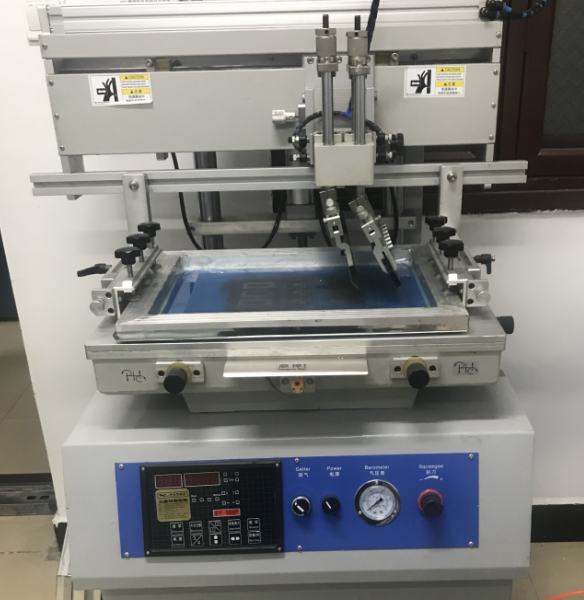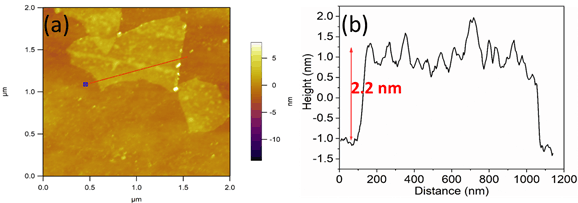Mxene丝网印刷膜的制备与导电性能研究毕业论文
2021-12-10 17:46:58
论文总字数:23029字
摘 要
印刷被认为是一种革命性的、可行的技术,用于指导设计结构的通用功能系统的制造。MXene作为当下很火的一种二维材料,由于其是金属碳化物和金属氮化物组成,具有很好的导电性和亲水性的特点。与其类似的二维材料作为丝网印刷膜的热门材料,在丝网印刷方向已取得一定的成果,于是联想到是否可以将MXene材料也应用于丝网印刷膜领域。本文使用氢氟酸剥离制得的MXene材料和黄原胶作为粘结剂配制得到的油墨在网板上进行印刷,对印刷得到的不同形状的膜进行各项性能的测试,通过对制备过程中不同指标的控制,致力于找到影响电导率的因素,并制备出尽可能高电导率的MXene膜。
首先用氢氟酸将剥离出来的MXene分散液干燥后,对分散液进行高速离心取下层悬浊液,然后冷凝干燥得到MXene材料。类比于石墨烯的丝网印刷方法,按照不同比例将MXene和粘结剂配制出油墨,然后在一个梯度的网板上进行印刷,得到MXene的丝网印刷膜,使其能够有比较好的导电性能。
其次,由于影响MXene膜导电性能的因素有很多,通过对碳系导电油墨的制备及印刷研究,分析其导电机理以及在丝网印刷中可能遇到的问题,并进行多次油墨配制的尝试,调整其中MXene与粘结剂的比例,得到比较适合丝网印刷的油墨配比为150 mg/ml,其中MXene与黄原胶的质量比为50:1。将配制出的MXene油墨进行丝网印刷,并对得到图案的表面以及截面的形貌进行SEM分析;再通过XRD测试其中的成分。
最后,通过对比文献中的对导电油墨对丝网印刷电路性能的影响,发现干燥条件、干燥温度和干燥时间都会对丝网印刷膜的导电性能有影响,于是在几种条件下将制得的MXene膜进行处理,并对其进行导电性能的测试。发现在120 ℃真空条件下干燥的MXene膜具有较好的导电性能;由于丝网印刷中的导电率还与图案的厚度有关,在不同的印刷道次制得的图案中,可以得到随着印刷道次增加图案方阻降低,即导电率提高的结论。
关键词:MXene油墨;丝网印刷;导电性能。
Abstract
Printing is considered a revolutionary, feasible technique for guiding the manufacture of a general-purpose functional system of a design structure.As a very popular two-dimensional material, MXene has good electronic conductivity, hydrophilicity and easy preparation because of its metal carbide and metal nitride composition. As a popular material for screen printing film, the carbon conductive ink graphite has achieved some results in the screen printing direction, so it is associated with whether MXene material can also be used in the field of screen printing film. In this paper, the ink prepared by hydrofluoric acid stripping MXene material and xanthan gum as binder is printed on the screen board, and the properties of the films with different shapes are tested. Through the control of different indexes in the preparation process, the factors affecting the conductivity are found, and the MXene membrane with as high conductivity as possible are prepared.
Firstly,after drying the peeled MXene dispersion with hydrofluoric acid, the dispersion was dehydrated and then dried by high speed centrifugation, and then the dried MXene material was obtained.Compared with graphene screen printing method, MXene and binder are prepared into ink according to different proportion, and then printed on a gradient screen board to obtain MXene screen printing membrane, so that it can have better electrical conductivity.
Secondly, because there are many factors that affect the conductivity of MXene film, through the preparation and printing of carbon conductive ink, the conductive mechanism and the problems that may be encountered in screen printing are analyzed, and many attempts are made to prepare the ink,the ratio of MXene to the binder is adjusted to obtain a more reasonable ratio of 150 mg/ ml MXene and xanthan gum at a ratio of 50:1.The prepared MXene ink is screen-printed, and the obtained patterns are subjected to AFM and SEM technical tests, and the surface and the cross-sectional shape of the obtained MXene ink are analyzed; and the components and the content are tested by the XRD.
Finally, by comparing the influence of conductive ink on the performance of screen printing circuit in the literature, it is found that the drying conditions, drying temperature and drying time all have influence on the electrical conductivity of screen printing film, so the MXene film prepared under several conditions is treated and tested by conductive properties.It is found that the MXene film dried at 120 ℃ vacuum has good conductivity, and because the conductivity in screen printing is also related to the thickness of the pattern, it can be concluded that the square resistance of the pattern decreases with the increase of the printing pass, that is, the conductivity increases.
Key Words:MXene Ink;Screen printing;Conductive properties.
目 录
摘 要 I
Abstract II
第1章 绪论 1
1.1二维材料 1
1.1.1单原子层二维材料 1
1.1.2多原子层二维材料 2
1.2 MXene丝网印刷膜 3
1.2.1导电油墨 3
1.2.2 MXene油墨 3
1.2.3丝网印刷技术 4
1.2.4 MXene膜的测试技术 5
1.3 MXene材料国内外研究近况 5
1.4 本文的研究目的、意义及主要研究工作 8
第2章 实验与测试技术 10
2.1实验试剂与实验设备 10
2.1.1实验试剂 10
2.1.2实验设备 10
2.2 MXene原料制备 11
2.2.1 MXene少层分散液的制备 11
2.2.2 MXene油墨的配制 11
2.2.3 MXene油墨丝网印刷 12
2.3 MXene膜的表征及测试技术 13
2.3.1扫描电子显微镜(SEM) 13
2.3.2原子力显微镜(AFM) 13
2.3.3 X射线衍射仪(XRD) 14
2.3.4四探针测阻仪(方阻测试仪) 14
第3章 MXene膜的表征及性能测试 15
3.1 引言 15
3.2 MXene膜的表征 15
3.2.1 MXene纳米片的AFM表征 15
3.2.2 MXene膜表面的SEM表征 15
3.2.3 MXene膜断面的SEM表征 17
3.2.4 导电性能的测试 18
3.2.5 XRD衍射图谱分析 18
3.2.6 印刷道次与方阻 19
第4章 结论与展望 23
参考文献 24
致 谢 26
第1章 绪论
随着智能和可穿戴电子设备的出现,刺激了不同尺寸的下一代柔性储能设备的发展,印刷电子的使用以及集成电路设备也引起了越来越多的关注。近年来,人们对使用直接印刷技术(如丝网印刷和挤压印刷)制造的储能装置越来越感兴趣,因为它们有足够的通用性来设计所需的图案并实现几何灵活性。而导电油墨作为丝网印刷中的关键材料,其对印刷电子技术起到至关重要的作用。在使用电子技术印制油墨材料的选择上,人们倾向于选择具有假活性特点的过渡金属氧化物(例如MnO2,V2O5,和Co3O4),而最近几年兴起的二维材料也成为研究者们的热门研究领域。
1.1二维材料
二维材料,是指电子只能在二维的非纳米尺度(1-100 nm)上进行平面运动的材料,如纳米膜、超晶格、量子阱。二维材料是曼彻斯特大学Geim团队于2004年提出并成功分离出的材料——石墨烯[1],这是一种具有单一原子层的石墨材料。因为它独特的平面二维结构,电子或声子在三维方向的运动是受到限制的,因此它可以表现出独特的电学和热学性能。另外,如果构成二维材料的材料本身是具有铁电、介电、压电和铁磁等性质,而由二维材料制成的材料可以保持原来的结构和性能,这样就有期望得到具有优异的热和介电性能的二维材料。二维材料在很多领域中有着广阔的应用前景,如光电材料、新型半导体元件和新型储能装置。
1.1.1单原子层二维材料
单层原子二维材料最典型的就是石墨烯,也是目前研究较多的一种二维材料。最初是通过机械剥离法从石墨中分离制得的石墨烯,Geim等人的工作也证明了单层碳原子石墨烯可以稳定存在。从结构上来分析,石墨晶体中每个碳原子都通过三个共价键与周围的碳原子相连,每六个碳原子就组成一个六元环结构,不断延伸形成片层结构,由于每一层之间距离较大,故碳原子层之间通过范德华力连接。石墨的导电性比一般非金属矿高一百倍,导热性超过钢、铁、铅等金属材料。而且石墨的导热、导电性能主要由单层原子的结构决定,所以分离成单原子层的石墨烯仍然拥有优异的导热、导电性能。
将单层的石墨烯制成二维材料后,减少了其宏观上的缺陷,导电导热性能也随之得到提升。另外,分离成石墨烯后,单个原子可以直接与环境接触,原子利用率提高,可以通过表面改性等方法进一步提高其应用性能。自石墨烯被发现以来,与碳相近的元素B、Si、P、Ge、Sn等元素的单原子层二维材料相继被开发出来,这一系列材料被命名为Xenes[2]。其中,X代表元素,ene是来源于graphene,表示烯。尽管这些二维单层烯的性能还不明确,但根据形成二维材料原本的物相的结构和性能,可以对这些Xenes材料的性能做出一定的预测。
请支付后下载全文,论文总字数:23029字
相关图片展示:









